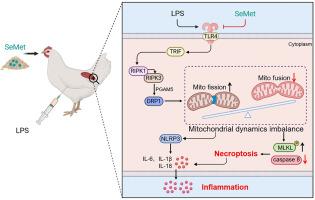Selenomethionine alleviates kidney necroptosis and inflammation by restoring lipopolysaccharide-mediated mitochondrial dynamics imbalance via the TLR4/RIPK3/DRP1 signaling pathway in laying hens
IF 3.8
1区 农林科学
Q1 AGRICULTURE, DAIRY & ANIMAL SCIENCE
引用次数: 0
Abstract
Selenomethionine (SeMet) is a beneficial organic source of selenium that is extensively used as a food additive owing to its antioxidant and anti-inflammatory properties. Due to the sensitivity of the kidneys to noxious stimuli, they are more susceptible to various injuries. To investigate the protective mechanisms of SeMet supplementation against kidney injury, we established an in vivo experimental model using laying hens treated with SeMet (0.5 mg/kg diet) and/or lipopolysaccharide (LPS) (0.2 mg/kg. BW) and an in vitro model of chicken embryo primary kidney (CEK) cells treated with SeMet (0.075 mM) and with/ without LPS (60 μg/mL). SeMet treatment alleviated the LPS-induced kidney insufficiency and mitochondrial damage. Furthermore, it reduced the expression of TLR4, RIPK3, MLKL, DRP1, NLRP3, and IL-1β in the kidneys of laying hens. RIPK3 is known to induced necroptosis and inflammation by activating of the downstream factors DRP1 and MLKL. To investigate the mechanism whereby SeMet alleviates LPS-induced necroptosis in the kidney, we pretreated CEK cells with TLR4, RIPK3, and DRP1 inhibitors. The results demonstrated that RIPK3 inhibition resulted in a significantly increased in the mitochondrial membrane potential and downregulation of DRP1. Upon the inhibition of DRP1 expression, MLKL, NLRP3, and IL-1β expression also decreased. In summary, SeMet regulates the TLR4/RIPK3/DRP1 signaling pathway to restore the LPS-induced imbalances in mitochondrial dynamics, thereby alleviating necroptosis and inflammation in the kidneys of laying hen. Selenium also increases the expression of selenoproteins. This study provides valuable information for the development of new therapeutic strategies using SeMet to alleviate kidney injury.

硒蛋氨酸通过TLR4/RIPK3/DRP1信号通路恢复脂多糖介导的线粒体动力学失衡,从而缓解蛋鸡肾脏坏死和炎症。
硒蛋氨酸(SeMet)是一种有益的有机硒源,因其抗氧化和抗炎特性而被广泛用作食品添加剂。由于肾脏对有害刺激非常敏感,因此更容易受到各种伤害。为了研究补充 SeMet 对肾损伤的保护机制,我们建立了一个体内实验模型,使用 SeMet(0.5 毫克/千克日粮)和/或脂多糖(LPS)(0.2 毫克/千克体重)处理蛋鸡,以及一个体外模型,使用 SeMet(0.075 毫摩尔)处理鸡胚原代肾(CEK)细胞,并添加/不添加 LPS(60 微克/毫升)。SeMet 处理减轻了 LPS 诱导的肾功能不全和线粒体损伤。此外,它还降低了蛋鸡肾脏中 TLR4、RIPK3、MLKL、DRP1、NLRP3 和 IL-1β 的表达。众所周知,RIPK3 可通过激活下游因子 DRP1 和 MLKL 诱导坏死和炎症。为了研究 SeMet 缓解 LPS 诱导的肾脏坏死的机制,我们用 TLR4、RIPK3 和 DRP1 抑制剂预处理 CEK 细胞。结果表明,抑制 RIPK3 会导致线粒体膜电位显著升高,并下调 DRP1。抑制 DRP1 表达后,MLKL、NLRP3 和 IL-1β 的表达也随之下降。总之,SeMet 可调节 TLR4/RIPK3/DRP1 信号通路,恢复 LPS 诱导的线粒体动力学失衡,从而缓解蛋鸡肾脏的坏死和炎症。硒还能增加硒蛋白的表达。这项研究为开发使用 SeMet 缓解肾损伤的新治疗策略提供了有价值的信息。
本文章由计算机程序翻译,如有差异,请以英文原文为准。
求助全文
约1分钟内获得全文
求助全文
来源期刊

Poultry Science
农林科学-奶制品与动物科学
CiteScore
7.60
自引率
15.90%
发文量
0
审稿时长
94 days
期刊介绍:
First self-published in 1921, Poultry Science is an internationally renowned monthly journal, known as the authoritative source for a broad range of poultry information and high-caliber research. The journal plays a pivotal role in the dissemination of preeminent poultry-related knowledge across all disciplines. As of January 2020, Poultry Science will become an Open Access journal with no subscription charges, meaning authors who publish here can make their research immediately, permanently, and freely accessible worldwide while retaining copyright to their work. Papers submitted for publication after October 1, 2019 will be published as Open Access papers.
An international journal, Poultry Science publishes original papers, research notes, symposium papers, and reviews of basic science as applied to poultry. This authoritative source of poultry information is consistently ranked by ISI Impact Factor as one of the top 10 agriculture, dairy and animal science journals to deliver high-caliber research. Currently it is the highest-ranked (by Impact Factor and Eigenfactor) journal dedicated to publishing poultry research. Subject areas include breeding, genetics, education, production, management, environment, health, behavior, welfare, immunology, molecular biology, metabolism, nutrition, physiology, reproduction, processing, and products.
 求助内容:
求助内容: 应助结果提醒方式:
应助结果提醒方式:


